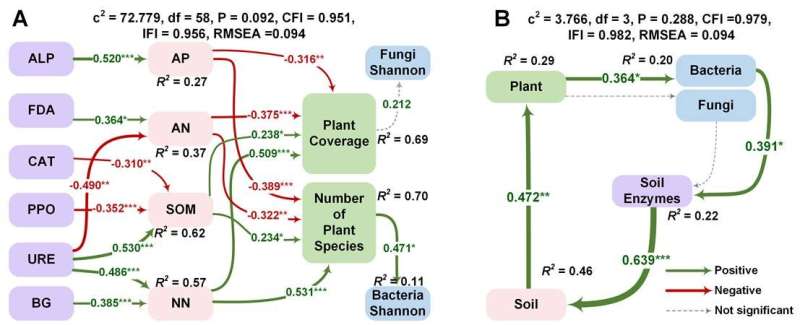Soil microbes-mediated enzymes promoted the ecological recovery of mine on Loess Plateau

The diversity of vegetation configuration is the key to ecological restoration in open-pit coal mine dump. However, the recovery outcomes of different areas with the same vegetation assemblage pattern are completely different after long-term evolution. Therefore, understanding the causes of differential vegetation recovery and the mechanism of plant succession is of great significance to the ecological restoration of mines. This study demonstrates that soil urease and β-glucosidase promoted the increase of vegetation diversity and biomass by promoting the accumulation of soil organic matter and nitrate nitrogen, which promoted the ecological restoration of mine dumps. The researchers' finding appeared on July 7, 2022 in Soil Ecology Letters.
A series of studies on the restoration of damaged mine ecosystem have been conducted by Fu Chen's team at the China University of Mining and Technology, and many interesting findings have been obtained. For example, the successional direction of the Pinus tabulaeformis plantations significantly shifted due to the invasion of surrounding plants, which resulted in an obvious increase in species number and vegetation coverage. They also found the original vegetation configuration, soil nutrient conditions and soil microbial communities were altered due to secondary succession. However, the influence and underlying mechanism of monoculture plantations on the secondary succession of mine ecosystem are not well understood.
Professor Chen said, "We chose to study the Antaibao open-pit coal mine located in the eastern Loess Plateau, where some artificial restoration projects begun in 1992. Plantations with the same vegetation configuration and artificial management measures had different restoration effects after 30 years of recovery time. Therefore, the Antaibao open-pit coal mine provides a proper and high-quality platform for mechanism study of monoculture plantations on the secondary succession of mine ecosystem."
In this study, they found that original vegetation configuration and soil nutrient conditions were altered due to secondary succession. With the advancement of the secondary succession process, the coverage of plants increased from 34.8% to 95.5%, soil organic matter increased from 9.30 g·kg-1 to 21.13 g·kg-1, and total nitrogen increased from 0.38 g·kg-1 to 1.01 g·kg-1. The activities of soil urease and β-glucosidase were increased by 1.7-fold and 53.26%, respectively.
Additionally, the secondary succession also changed the soil microbial community structure and function. The relative abundance of Nitrospira genus which dominates the nitrification increased 5.2-fold. This result suggests that the invasion and diffusion of native plants and surrounding plants had a positive effect on ecological restoration, which is helpful to explore more reasonable selection and configuration of vegetation in the practice of mine ecological restoration.
"We also used the method of structural equation models and funcitional prediction to explore the role of microbes-mediated enzymes in the process of secondary succession and the interactions between plants, soil and microbes," said Professor Chen. The activities of several soil enzymes had a significantly positive impact on soil carbon, N, and P. And microbes played a positive role in facilitating plant and soil substance cycling on either scale. This result suggests the possibility of using industrial enzyme preparations such as urease and catalase to promote litter degradation, by improving soil fertility to accelerate the process of ecosystem cycle and succession.
"The study is an extension of our understanding of the ecological restoration in open-pit coal mine dump from plant configeration to microbial function, increasing our understanding of plant invasion and microbes-mediated enzymes in secondary succession of mine dumps on Loess Plateau."
More information: Qi Zhang et al, Soil microbes-mediated enzymes promoted the secondary succession in post-mining plantations on the Loess Plateau, China, Soil Ecology Letters (2022). DOI: 10.1007/s42832-022-0148-0
Provided by Higher Education Press




















